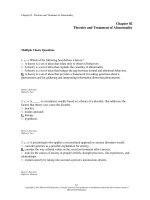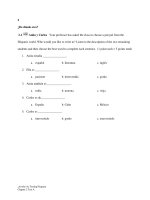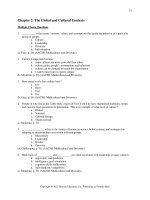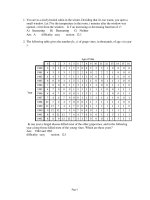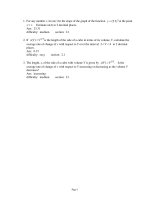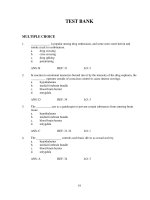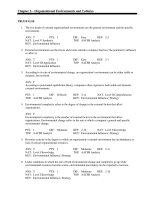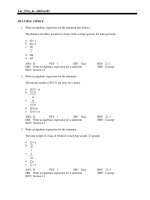Social problems in a diverse society 6th edition diana kendall test bank
Bạn đang xem bản rút gọn của tài liệu. Xem và tải ngay bản đầy đủ của tài liệu tại đây (224.36 KB, 12 trang )
Chapter 2
Test Bank for Wealth and Poverty: U.S. and Global Economic
Inequities
True/False
Mult. Choice
Essay
Total Qs
Remember
8 (80%)
21 (70%)
0
29
Understand
2 (20%)
7 (23%)
0
9
Apply
0
2 (7%)
1 (20%)
3
Analyze
0
0
1 (20%)
1
Evaluate
0
0
2 (40%)
2
Create
0
0
1 (20%)
1
10
30
4
45
True or False Questions
1. In high-income nations such as the United States, most people have similar life chances.
a. true
b. false
Answer: b. false
Difficulty: 1
Bloom’s Level: Remember
Page Reference: 27
2. Karl Marx believed that inequality and poverty were inevitable by-products of the
exploitation of workers by capitalists.
a. true
b. false
Answer: a. true
Difficulty: 1
Bloom’s Level: Remember
Page Reference: 29
3. Income is the economic gain derived from wages, salaries, income transfers, or
ownership of property.
a. true
b. false
Answer: a. true
Difficulty: 1
Bloom’s Level: Remember
Page Reference: 31
4. Today, more than 1.4 billion people live in absolute poverty.
1
Copyright © 2013 Pearson Education, Inc. All rights reserved
a. true
b. false
Answer: a. true
Difficulty: 2
Bloom’s Level: Remember
Page Reference: 29
5. The U.S. poverty line is primarily based on a low-cost food budget for a family.
a. true
b. false
Answer: a. true
Difficulty: 1
Bloom’s Level: Remember
Page Reference: 34
6. The amount of low-income housing has increased significantly in recent years due to
programs such as Habitat for Humanity and federal housing initiatives.
a. true
b. false
Answer: b. false
Difficulty: 2
Bloom’s Level: Remember
Page Reference: 38
7. Countries with relatively low-income levels, high rates of absolute poverty, low life
expectancy, and high infant mortality rates are low-income nations.
a. true
b. false
Answer: a. true
Difficulty: 2
Bloom’s Level: Remember
Page Reference: 26
8. The feminization of poverty refers to the trend whereby women are disproportionately
represented among individuals living in poverty.
a. true
b. false
Answer: a. true
Difficulty: 1
Bloom’s Level: Remember
Page Reference: 36
9. Class systems contribute to social stratification.
a. true
b. false
2
Copyright © 2013 Pearson Education, Inc. All rights reserved
Answer: a. true
Difficulty: 2
Bloom’s Level: Understand
Page Reference: 29
10. Comparing the conflict and functionalist solutions to poverty, it is logical to conclude
that the conflict perspective is more conservative.
a. true
b. false
Answer: b. false
Difficulty: 3
Bloom’s Level: Understand
Page Reference: 44-45
3
Copyright © 2013 Pearson Education, Inc. All rights reserved
Multiple Choice Questions
1. Which of the following is based on individual ownership and resource control founded in
the type of work people do?
a. caste system
b. class system
c. democracy
d. socialism
Answer: b. class system
Difficulty: 1
Bloom’s Level: Remember
Page Reference: 25
2. When wealthy and powerful individuals and corporations make decisions that serve their
best interests while casting aside millions of the world’s people who are deprived of life’s
most basic and important necessities, they create
a. artificial scarcity.
b. food waste.
c. food loss.
d. social stratification.
Answer: a. artificial scarcity
Difficulty: 2
Bloom’s Level: Remember
Page Reference: 27
3. Which of the following statements most accurately describes class inequality in the United
States?
a. Despite the American Dream, the U.S. remains highly stratified.
b. The wealth and income gap between the richest and poorest U.S. households has
continued to narrow over recent decades.
c. Middle-class African Americans are beginning to accumulate as much wealth as
white Americans due to high-paying jobs.
d. Marx’s and Weber’s theories on stratification issues are mostly identical.
Answer: a. Despite the American Dream, the U.S. remains highly stratified.
Difficulty: 3
Bloom’s Level: Remember
Page Reference: 25
4. In reference to divisions in the U.S. class structure, physicians, attorneys, and
stockbrokers are located in which class?
a. capitalist
b. upper-middle
c. proletariat
d. middle
Answer: b. upper-middle
Difficulty: 1
4
Copyright © 2013 Pearson Education, Inc. All rights reserved
Bloom’s Level: Remember
Page-Reference: 32
5. According to the text, the working class is composed of
a. white-collar office workers.
b. people in occupations such as semiskilled machine operators in industrial
settings.
c. the chronically poor.
d. most service workers and the lowest-paid operatives and sales and clerical
workers.
Answer: b. people in occupations such as semiskilled machine operators in industrial
settings.
Difficulty: 1
Bloom’s Level: Remember
Page-Reference: 32-33
6. Which of the following statements regarding the chronically poor is correct?
a. The chronically poor make up about 40 percent of the U.S. population.
b. Children are not considered to be among the chronically poor.
c. Those unable to work because of age or disability often are chronically poor.
d. Single mothers are underrepresented among the chronically poor.
Answer: c. Those unable to work because of age or disability often are chronically poor.
Difficulty: 2
Bloom’s Level: Remember
Page-Reference: 33
7. The poverty line is based on the assumption that
a. one-fourth of a person’s income is spent on food.
b. one-third of a person’s income is spent on food.
c. one-half of a person’s income is spent on food.
d. three-fourths of a person’s income is spent on food.
Answer: b. one-third of a person’s income is spent on food.
Difficulty: 3
Bloom’s Level: Remember
Page Reference: 34
8. The vast majority of poor people in the United States are
a. women and children.
b. men.
c. elderly.
d. disabled and infirm.
Answer: a. women and children.
Difficulty: 1
Bloom’s Level: Remember
Page-Reference: 36
5
Copyright © 2013 Pearson Education, Inc. All rights reserved
9. Which of the following statements best describes food insecurity?
a. One-half of U. S. households are considered to be food insecure at some point
during the year.
b. Prolonged food insecurity poses no risk to health and well-being.
c. Food insecurity has increased in recent years because of increases in poverty and
unemployment rates.
d. Food insecurity has decreased in recent years because of decreases in poverty
and unemployment rates.
Answer: c. Food insecurity has increased in recent years because of increases in poverty
and unemployment rates.
Difficulty: 2
Bloom’s Level: Remember
Page Reference: 38
10. Most researchers argue that the most frequent cause of homelessness is
a. gender and discrimination.
b. race and discrimination.
c. poverty and job loss.
d. the welfare state.
Answer: c. poverty and job loss
Difficulty: 2
Bloom’s Level: Remember
Page Reference: 39
11. The practice used by people who view a social problem as emanating from within the
individual exhibiting the problem is known as
a. blaming the victim.
b. blaming “the man.”
c. blaming the system.
d. blaming the culture.
Answer: a. blaming the victim
Difficulty: 1
Bloom’s Level: Remember
Page Reference: 43
12. A business executive earning $50,000 annually in the 1930s would earn around
$500,000 today. This increase is based upon
a. cultural capital.
b. constant dollars and current dollars.
c. wage squeeze.
d. sympathetic framing.
Answer: b. constant dollars and current dollars.
Difficulty: 2
Bloom’s Level: Remember
Page Reference: 44
6
Copyright © 2013 Pearson Education, Inc. All rights reserved
13. Oscar Lewis’s idea that some poor people develop a separate and self-perpetuating
system of attitudes and behaviors that keeps them trapped in poverty is known as
a. the system of checks and balances.
b. the cultural explanation of negative framing.
c. the cultural explanation of capital.
d. the culture of poverty hypothesis.
Answer: d. the culture of poverty hypothesis.
Difficulty: 1
Bloom’s Level: Remember
Page Reference: 43
14. Which of the following initiatives created farm subsidies, minimum wage standards, and
the Social Security system?
a. Franklin D. Roosevelt’s New Deal in the 1930s
b. Lyndon B. Johnson’s War on Poverty programs in the 1960s
c. Bill Clinton’s Personal Responsibility and Work Opportunity and Reconciliation Act
in the 1990s
d. Barack Obama’s Tax Relief Unemployment Insurance Reauthorization and Job
Creation Act in the 2010s
Answer: a. Franklin D. Roosevelt’s New Deal in the 1930s
Difficulty: 2
Bloom’s Level: Remember
Page Reference: 41
15. Regarding social problems in the media, sympathetic framing is most likely used when
a. individuals in the story are children, elderly individuals, or persons with an illness
or disability.
b. individuals in the story are women or members of an ethnic minority.
c. individuals in the story are men or members of an ethnic majority.
d. individuals in the story are veterans.
Answer: a. individuals in the story are children, elderly individuals, or persons with an
illness or disability.
Difficulty: 2
Bloom’s Level: Remember
Page Reference: 41-42 (Box 2.3)
16. Which three major programs were expanded by the American Recovery and
Reinvestment Act of 2009?
a. Medicaid, Temporary Assistance for Needy Families (TANF), and the Work
Opportunity Tax Credit (WOTC)
b. the Food and Agricultural Organization (FAO), the World Trade Center (WTC), and
Assistance for Women, Infants, and Children (WIC)
c. the U.S. Census Bureau, the Federal Trade Commission (FTC), and the dole
d. SNAP (food stamps), unemployment insurance benefits, and Social Security
Answer: d. SNAP (food stamps), unemployment insurance benefits, and Social Security
Difficulty: 3
Bloom’s Level: Remember
7
Copyright © 2013 Pearson Education, Inc. All rights reserved
Page Reference: 43
17. Which
a.
b.
c.
d.
one of the following is most likely to fall into poverty?
dual-income families
single female-headed families
single male-headed families
elderly families
Answer: b. single female-headed families
Difficulty: 1
Bloom’s Level: Remember
Page Reference: 36
18. Which of the following perspectives asserts that poverty-related problems can be
reduced by strengthening our major social institutions?
a. conflict perspective
b. symbolic interactionist perspective
c. functionalist perspective
d. feminist perspective
Answer: c. functionalist perspective
Difficulty: 2
Bloom’s Level: Remember
Page Reference: 45
19. Conflict theorists would suggest that
a. people in poverty are poorly motivated.
b. the problem of poverty can only be solved by reducing inequality.
c. to reduce poverty, we should find more constructive ways to think about poor
people individually.
d. stigma has a profound effect upon those who are labeled.
Answer: b. the problem of poverty can only be solved by reducing inequality.
Difficulty: 2
Bloom’s Level: Remember
Page Reference: 45
20. Overhauling housing policies and strengthening job-training programs would be
considered
a. functionalist solutions to poverty.
b. conflict solutions to poverty.
c. symbolic interactionist solutions to poverty.
d. feminist solutions to poverty.
Answer: b. conflict solutions to poverty
Difficulty: 2
Bloom’s Level: Remember
Page Reference: 45
8
Copyright © 2013 Pearson Education, Inc. All rights reserved
21. Which approach makes us aware that social change must occur at both the micro- and
macrolevel to reduce poverty?
a. culture of poverty hypothesis
b. system of constant and current dollars
c. functionalist perspective
d. symbolic interactionist perspective
Answer: d. symbolic interactionist perspective
Difficulty: 2
Bloom’s Level: Remember
Page Reference: 46
22. The “American Dream” can best be summarized as
a. the belief in the phrase “Live and let live.”
b. the belief that anyone can become famous.
c. the belief that anyone can become successful.
d. the belief that anyone can become rich.
Answer: c. the belief that anyone can become successful.
Difficulty: 1
Bloom’s Level: Understand
Page Reference: 25
23. Why do sociologists analyze secondary data when they conduct research on wealth and
poverty around the world?
a. because these data focus on poverty indicators
b. because these data focus on low-income nations only
c. because these data are based upon the culture of poverty hypothesis
d. because these data focus on quality-of-life indicators for high-, middle-, and lowincome nations
Answer: d. because these data focus on quality-of-life indicators for high-, middle-, and lowincome nations
Difficulty: 4
Bloom’s Level: Understand
Page Reference: 26
24. What is the reason for food loss in poorer countries?
a. Expiration dates cause many consumers to throw away edible food.
b. Consumers are not aware of good and beneficial ways to use safe food that is
presently being thrown away.
c. Many problems occur because poor nations are technologically hindered.
d. Advances in harvesting, storage, and packaging of food has caused most food
loss problems.
Answer: c. Many problems occur because poor nations are technologically hindered.
Difficulty: 5
Bloom’s Level: Understand
Page Reference: 28 (Box 2.1)
9
Copyright © 2013 Pearson Education, Inc. All rights reserved
25. How was the U.S.’s social stratification evaluated by Karl Marx?
a. Marx divided capitalist societies into two categories: the bourgeoisie and the
proletariat.
b. Marx believed that economic factors alone were not the sole determinants in
class and social equality.
c. Marx believed that wealth, power, and prestige play roles in people’s class
positions.
d. Marx identified four classes in the U.S. economical system.
Answer: a. Marx divided capitalist societies into two categories: the bourgeoisie and the
proletariat.
Difficulty: 2
Bloom’s Level: Understand
Page Reference: 29-30
26. Which
poverty?
a.
b.
c.
d.
one of the following groups is best described by the term racial feminization of
men of color
white female-headed households
white females
women of color
Answer: d. women of color
Difficulty: 1
Bloom’s Level: Understand
Page Reference: 36-37
27. Employers who enjoy tax credits for hiring welfare recipients are benefiting from
a. the New Deal.
b. the War on Poverty program.
c. the Small Business Job Protection Act.
d. the Job Creation Act.
Answer: c. the Small Business Job Protection Act.
Difficulty: 2
Bloom’s Level: Understand
Page Reference: 42
28. The decrease in take-home pay of workers since the 1980s is also known as
a. constant dollars.
b. current dollars.
c. poverty squeeze.
d. wage squeeze.
Answer: d. wage squeeze
Difficulty: 2
Bloom’s Level: Understand
Page Reference: 44
10
Copyright © 2013 Pearson Education, Inc. All rights reserved
29. Julie is a high school dropout and a single mother with three children who works as a
waitress earning minimum wage. Julie spends 30% of her income on food and 70% on rent
for her and her children. She doesn't earn enough to pay for utilities and many other
needed items. Julie and her children are in
a. absolute poverty due to the feminization of poverty.
b. relative poverty due to the feminization of poverty.
c. absolute poverty because of the welfare state.
d. relative poverty because of the welfare state.
Answer: b. relative poverty due to the feminization of poverty.
Difficulty: 3
Bloom’s Level: Apply
Page Reference: 29
30. James is a high school graduate and semiskilled laborer who is going back to school to
attain his associate’s degree. James is trying to improve his
a. cultural capital.
b. culture of poverty.
c. human capital.
d. investment capital.
Answer: c. human capital
Difficulty: 3
Bloom’s Level: Apply
Page Reference: 43
Essay Questions (Answers will vary.)
1. Describe the American Dream and explain why the contemporary U.S. class structure
may make it difficult for some people to achieve this dream. Provide five examples to
support your explanation.
Difficulty: 9
Bloom’s Level: Apply
Page Reference: 25-29
2. Contrast high-, middle-, and low-income nations.
Difficulty: 2
Bloom’s Level: Analyze
Page Reference: 26
3. Describe the major weaknesses of welfare programs that have existed in the United
States. What individual, cultural, and/or structural solutions have been posed for reducing
or eliminating poverty? What have been the effects of recent attempts at welfare reform?
Difficulty: 8
Bloom’s Level: Evaluate
Page Reference: 40-43
11
Copyright © 2013 Pearson Education, Inc. All rights reserved
4. Evaluate how the distribution of wealth and poverty differs by race, class, gender, and
age in the United States, based on the information presented in the textbook.
Difficulty: 7
Bloom’s Level: Evaluate
Page Reference: 26-43
5. Propose a way to reduce poverty in the U.S. Assume you have ample economic and
political resources. Use Marx's, Weber's, and Wright's ideas to support your efforts.
Difficulty: 8
Bloom’s Level: Create
Page-Reference: 29-30
12
Copyright © 2013 Pearson Education, Inc. All rights reserved
